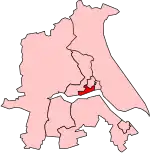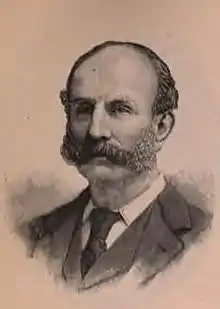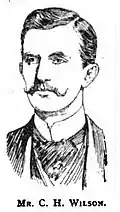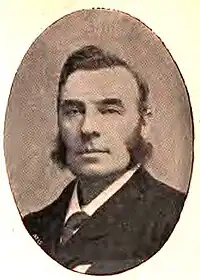| Kingston upon Hull West | |
|---|---|
| Former Borough constituency for the House of Commons | |
 Kingston upon Hull West in Humberside, showing boundaries used from 1983–1997 | |
| Major settlements | Kingston upon Hull |
| 1955–1997 | |
| Seats | One |
| Created from | Hull Central and Haltemprice |
| Replaced by | Hull West and Hessle |
| 1885–1918 | |
| Seats | One |
| Type of constituency | Borough constituency |
| Created from | Kingston upon Hull |
| Replaced by | Hull North West and Hull South West |
Kingston upon Hull West was a borough constituency in Kingston upon Hull which returned one Member of Parliament (MP) to the House of Commons of the Parliament of the United Kingdom from 1885 until it was abolished for the 1918 general election.
It was recreated for the 1955 general election and abolished again for the 1997 general election. It was then replaced by the new Hull West and Hessle constituency.
History
Boundaries
1885–1918: The Municipal Borough of Kingston-upon-Hull wards of Albert, Botanic, Coltman, Newington, and Park.
1955–1974: The County Borough of Kingston-upon-Hull wards of Albert, Coltman, North Newington, Pickering, St Andrew's, and South Newington.
1974–1983: The County Borough of Kingston-upon-Hull wards of Boothferry, Coltman, Derringham, Newington, Pickering, and St Andrew's.
1983–1997: The City of Hull wards of Boothferry, Derringham, Myton, Newington, Pickering, and St Andrew's.
Members of Parliament
MPs 1885–1918
| Election | Member[1] | Party[2] | |
|---|---|---|---|
| 1885 | Charles Wilson | Liberal | |
| 1906 | Charles Wilson | Liberal | |
| 1907 | Guy Wilson | Liberal | |
| 1918 | Constituency abolished | ||
MPs 1955–1997
| Election | Member[1] | Party | |
|---|---|---|---|
| 1955 | Mark Hewitson | Labour | |
| 1964 | James Johnson | Labour | |
| 1983 | Stuart Randall | Labour | |
| 1997 | Constituency abolished: see Hull West and Hessle | ||
Elections
Elections in the 1880s

| Party | Candidate | Votes | % | ±% | |
|---|---|---|---|---|---|
| Liberal | Charles Wilson | 5,247 | 58.7 | ||
| Conservative | Albert Rollit | 3,697 | 41.3 | ||
| Majority | 1,550 | 17.4 | |||
| Turnout | 8,944 | 77.7 | |||
| Registered electors | 11,517 | ||||
| Liberal win (new seat) | |||||

| Party | Candidate | Votes | % | ±% | |
|---|---|---|---|---|---|
| Liberal | Charles Wilson | 4,623 | 60.3 | +1.6 | |
| Conservative | Arthur Knocker Dibb [6] | 3,045 | 39.7 | −1.6 | |
| Majority | 1,578 | 20.6 | +3.2 | ||
| Turnout | 7,668 | 66.6 | −11.1 | ||
| Registered electors | 11,517 | ||||
| Liberal hold | Swing | +1.6 | |||
Elections in the 1890s
| Party | Candidate | Votes | % | ±% | |
|---|---|---|---|---|---|
| Liberal | Charles Wilson | 6,283 | 64.2 | +3.9 | |
| Liberal Unionist | Goldwin Smith | 3,500 | 35.8 | −3.9 | |
| Majority | 2,783 | 28.4 | +7.8 | ||
| Turnout | 9,783 | 70.2 | +3.6 | ||
| Registered electors | 13,929 | ||||
| Liberal hold | Swing | +3.9 | |||
| Party | Candidate | Votes | % | ±% | |
|---|---|---|---|---|---|
| Liberal | Charles Wilson | 6,637 | 82.6 | +18.4 | |
| Ind. Labour Party | Tom McCarthy | 1,400 | 17.4 | New | |
| Majority | 5,237 | 65.2 | +36.8 | ||
| Turnout | 8,037 | 55.4 | −14.8 | ||
| Registered electors | 14,520 | ||||
| Liberal hold | Swing | N/A | |||
Elections in the 1900s
| Party | Candidate | Votes | % | ±% | |
|---|---|---|---|---|---|
| Liberal | Charles Wilson | 6,364 | 59.0 | −23.6 | |
| Conservative | John Bouch Willows | 4,419 | 41.0 | New | |
| Majority | 1,945 | 18.0 | −47.2 | ||
| Turnout | 10,783 | 64.3 | +8.9 | ||
| Registered electors | 16,757 | ||||
| Liberal hold | Swing | N/A | |||

| Party | Candidate | Votes | % | ±% | |
|---|---|---|---|---|---|
| Liberal | Charles Wilson | 8,652 | 57.5 | −1.5 | |
| Liberal Unionist | John Sherburn | 6,405 | 42.5 | +1.5 | |
| Majority | 2,247 | 15.0 | −3.0 | ||
| Turnout | 15,057 | 74.6 | +10.3 | ||
| Registered electors | 20,192 | ||||
| Liberal hold | Swing | −1.5 | |||

| Party | Candidate | Votes | % | ±% | |
|---|---|---|---|---|---|
| Liberal | Guy Wilson | 5,623 | 36.2 | −21.3 | |
| Conservative | George Trout Bartley | 5,382 | 34.7 | −7.8 | |
| Labour | James Holmes | 4,512 | 29.1 | New | |
| Majority | 241 | 1.5 | −13.5 | ||
| Turnout | 15,517 | 75.4 | +0.8 | ||
| Registered electors | 20,583 | ||||
| Liberal hold | Swing | −6.8 | |||
Elections in the 1910s
| Party | Candidate | Votes | % | ±% | |
|---|---|---|---|---|---|
| Liberal | Guy Wilson | 10,005 | 54.7 | −2.8 | |
| Liberal Unionist | John Sherburn | 8,288 | 45.3 | +2.8 | |
| Majority | 1,717 | 9.4 | −5.6 | ||
| Turnout | 18,293 | 80.9 | +6.3 | ||
| Registered electors | 22,609 | ||||
| Liberal hold | Swing | −2.8 | |||
| Party | Candidate | Votes | % | ±% | |
|---|---|---|---|---|---|
| Liberal | Guy Wilson | 9,236 | 53.8 | −0.9 | |
| Conservative | Lambert Ward | 7,943 | 46.2 | +0.9 | |
| Majority | 1,293 | 7.6 | −1.8 | ||
| Turnout | 17,179 | 76.0 | −4.9 | ||
| Registered electors | 22,609 | ||||
| Liberal hold | Swing | −0.9 | |||
General election 1914–15:
Another general election was required to take place before the end of 1915. The political parties had been making preparations for an election to take place and by July 1914, the following candidates had been selected;
- Labour: Alfred Gould
- Liberal: Guy Wilson
- National Sailors' and Firemen's Union: John R. Bell
- Unionist: W. H. Grace
Elections in the 1950s
| Party | Candidate | Votes | % | ±% | |
|---|---|---|---|---|---|
| Labour | Mark Hewitson | 25,785 | 56.00 | ||
| Conservative | Reginald Northam | 20,262 | 44.00 | ||
| Majority | 5,523 | 12.00 | |||
| Turnout | 46,047 | 70.12 | |||
| Labour win (new seat) | |||||
| Party | Candidate | Votes | % | ±% | |
|---|---|---|---|---|---|
| Labour | Mark Hewitson | 25,446 | 52.51 | ||
| Conservative | Thomas H. F. Farrell | 23,011 | 47.49 | ||
| Majority | 2,435 | 5.02 | |||
| Turnout | 48,457 | 75.60 | |||
| Labour hold | Swing | ||||
Elections in the 1960s
| Party | Candidate | Votes | % | ±% | |
|---|---|---|---|---|---|
| Labour | James Johnson | 24,855 | 56.90 | ||
| Conservative | John G. Bellak | 18,825 | 43.10 | ||
| Majority | 6,030 | 13.80 | |||
| Turnout | 43,680 | 70.94 | |||
| Labour hold | Swing | ||||
| Party | Candidate | Votes | % | ±% | |
|---|---|---|---|---|---|
| Labour | James Johnson | 26,816 | 64.82 | ||
| Conservative | Giles Shaw | 14,551 | 35.18 | ||
| Majority | 12,265 | 29.64 | |||
| Turnout | 41,367 | 70.42 | |||
| Labour hold | Swing | ||||
Elections in the 1970s
| Party | Candidate | Votes | % | ±% | |
|---|---|---|---|---|---|
| Labour | James Johnson | 24,050 | 62.33 | ||
| Conservative | Timothy Edward Forrow | 14,537 | 37.67 | ||
| Majority | 9,513 | 24.66 | |||
| Turnout | 38,587 | 64.79 | |||
| Labour hold | Swing | ||||
| Party | Candidate | Votes | % | ±% | |
|---|---|---|---|---|---|
| Labour | James Johnson | 20,719 | 49.33 | ||
| Conservative | Charles Maxwell Kirwin Taylor | 12,788 | 30.44 | ||
| Liberal | I. Silverwood | 8,497 | 20.23 | New | |
| Majority | 7,931 | 18.89 | |||
| Turnout | 42,004 | 73.59 | |||
| Labour hold | Swing | ||||
| Party | Candidate | Votes | % | ±% | |
|---|---|---|---|---|---|
| Labour | James Johnson | 20,393 | 54.86 | ||
| Conservative | Charles Maxwell Kirwin Taylor | 10,272 | 27.63 | ||
| Liberal | Anthony Ronald Michell | 6,508 | 17.51 | ||
| Majority | 10,121 | 27.23 | |||
| Turnout | 37,173 | 64.55 | |||
| Labour hold | Swing | ||||
| Party | Candidate | Votes | % | ±% | |
|---|---|---|---|---|---|
| Labour | James Johnson | 19,750 | 55.78 | ||
| Conservative | R. E. Smith | 11,592 | 32.74 | ||
| Liberal | S. J. Foston | 3,656 | 10.33 | ||
| National Front | M. D. Fox | 411 | 1.16 | New | |
| Majority | 8,158 | 23.04 | |||
| Turnout | 35,409 | 67.46 | |||
| Labour hold | Swing | ||||
Elections in the 1980s
| Party | Candidate | Votes | % | ±% | |
|---|---|---|---|---|---|
| Labour | Stuart Randall | 15,361 | 41.92 | ||
| Conservative | Martin Robert Charles Humphreys | 11,707 | 31.95 | ||
| SDP | Stephen Unwin | 9,575 | 26.13 | New | |
| Majority | 3,654 | 9.97 | |||
| Turnout | 36,643 | 63.50 | |||
| Labour hold | Swing | ||||
| Party | Candidate | Votes | % | ±% | |
|---|---|---|---|---|---|
| Labour | Stuart Randall | 19,527 | 51.94 | ||
| Conservative | Martin Robert Charles Humphreys | 11,397 | 30.32 | ||
| SDP | Martyn Arthur Bond | 6,669 | 17.74 | ||
| Majority | 8,130 | 21.62 | |||
| Turnout | 37,593 | 67.57 | |||
| Labour hold | Swing | ||||
Election in the 1990s
| Party | Candidate | Votes | % | ±% | |
|---|---|---|---|---|---|
| Labour | Stuart Randall | 21,139 | 57.3 | +5.4 | |
| Conservative | Donald M. Stewart | 10,554 | 28.6 | −1.7 | |
| Liberal Democrats | Robert D. Tress | 4,867 | 13.2 | −4.5 | |
| Natural Law | Barry J. Franklin | 308 | 0.8 | New | |
| Majority | 10,585 | 28.7 | +7.1 | ||
| Turnout | 36,868 | 65.7 | −1.9 | ||
| Labour hold | Swing | +3.5 | |||
Notes and references
- 1 2 Leigh Rayment's Historical List of MPs – Constituencies beginning with "H" (part 4)
- ↑ Craig, F. W. S. (1989) [1974]. British parliamentary election results 1885–1918 (2nd ed.). Chichester: Parliamentary Research Services. p. 130.
- 1 2 3 4 5 6 The Liberal Year Book, 1907.
- ↑ Debrett's House of Commons & Judicial Bench, 1886.
- 1 2 3 4 5 6 7 Craig, F. W. S., ed. (1974). British Parliamentary Election Results: 1885–1918. London: Macmillan Press. ISBN 9781349022984.
- ↑ "Yorkshire Candidates". Yorkshire Post and Leeds Intelligencer. 10 July 1886. p. 8. Retrieved 29 November 2017 – via British Newspaper Archive.
- 1 2 Debrett's House of Commons & Judicial Bench, 1901.
- 1 2 Craig, 1885–1918, p. 130.
- 1 2 3 British parliamentary election results, 1950–1973, by F. W. S. Craig.
- 1 2 F. W. S. Craig, British Parliamentary Election Results 1950–1973; Political Reference Publications, Glasgow 1973.
- ↑ "Election Data 1983". Electoral Calculus. Archived from the original on 15 October 2011. Retrieved 28 June 2017.
- ↑ "Election Data 1987". Electoral Calculus. Archived from the original on 15 October 2011. Retrieved 28 June 2017.
- ↑ "Election Data 1992". Electoral Calculus. Archived from the original on 15 October 2011. Retrieved 28 June 2017.
- ↑ "Politics Resources". Election 1992. Politics Resources. 9 April 1992. Archived from the original on 24 July 2011. Retrieved 6 December 2010.